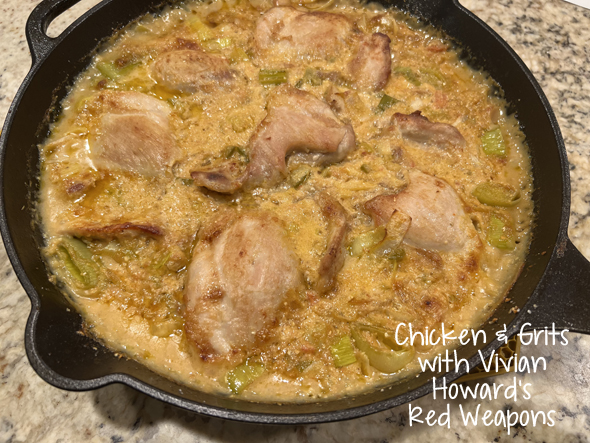 OMGoodness. Was this ever beyond delicious.
OMGoodness. Was this ever beyond delicious.
A couple of weeks ago I wrote up a post about Vivian Howard’s book, This Will Make It Taste Good. And about my friend Cherrie and I getting together to cook for a day and making three of the flavor enhancers Vivian shares in the book. This post is about the one called Red Weapons.
To make this chicken and grits, you need to make the Red Weapons. They’re not hard – not in the least. But it is a separate process, and they need to be made a day ahead, at least. The red weapons mixture Vivian says will keep in the frig for 3 months. It’s a pickled kind of mixture but also contains EVOO.
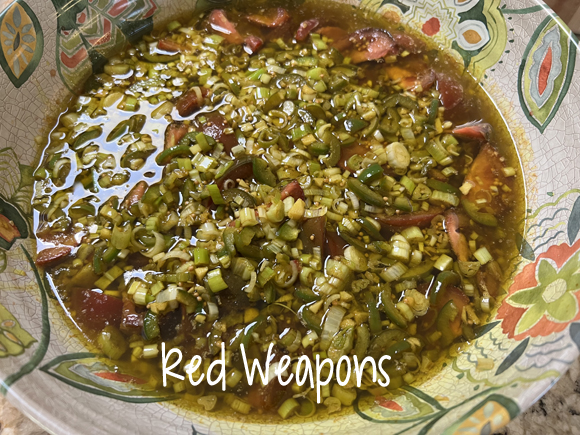 What’s in it? First you cut up 2 pounds of tomatoes, put them in a bowl. Glass one if you have it. Then in a big saucepan you combine green onions, jalapenos, fresh ginger, garlic, cumin, mustard seeds, cayenne, turmeric, brown sugar, EVOO, salt, unseasoned rice wine vinegar and white wine vinegar. The mixture is heated to a boil then it’s poured over the bowl of tomatoes. It’s set aside to sit, for many hours, or even overnight. This allows all those flavors to mingle – once you refrigerate this it will stop the flavor-mingling. Because of all the vinegar it contains, it IS a pickling liquid, but tempered by the EVOO. While you heat it up and then pour all that hot liquid over the tomatoes, it semi-cooks the mixture. The tomatoes stay relatively intact.
What’s in it? First you cut up 2 pounds of tomatoes, put them in a bowl. Glass one if you have it. Then in a big saucepan you combine green onions, jalapenos, fresh ginger, garlic, cumin, mustard seeds, cayenne, turmeric, brown sugar, EVOO, salt, unseasoned rice wine vinegar and white wine vinegar. The mixture is heated to a boil then it’s poured over the bowl of tomatoes. It’s set aside to sit, for many hours, or even overnight. This allows all those flavors to mingle – once you refrigerate this it will stop the flavor-mingling. Because of all the vinegar it contains, it IS a pickling liquid, but tempered by the EVOO. While you heat it up and then pour all that hot liquid over the tomatoes, it semi-cooks the mixture. The tomatoes stay relatively intact. 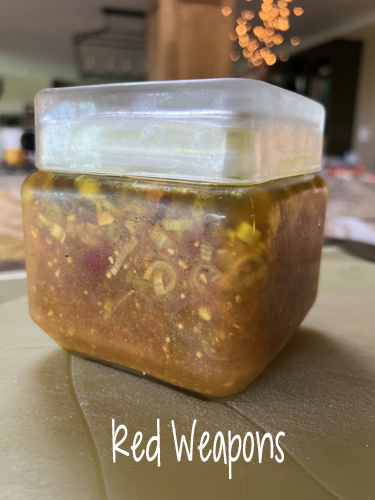
The recipe below makes twice this amount, pictured. At right is a quart of it (half). The EVOO is sitting there on top and the red weapons and the pickling liquid below that (called for separately in most of the recipes that accompanied the red weapons recipe in the cookbook). If you make this, store it in a wide mouthed glass container (do NOT use plastic). Or you can divide the mixture into several smaller containers – just use wide mouthed ones as the congealed EVOO on top makes it hard to get to the goodies underneath.
WARNING: turmeric stains everything it touches. There’s only 1 1/2 teaspoons in the entire batch, but it gets on everything – your counter, your clean-up sponge, and if you mop any of it up with a paper towel, you’ll sure know there’s turmeric in it. But you can’t taste the turmeric at all. Funny how that is. The tomatoes and jalapenos are the primary flavors here. Ideally the mixture is left out at room temp overnight, then it’s refrigerated.
In the cookbook, Vivian suggests you can use the red weapons for these things: on any kind of cooked egg, added to braising liquid (stews, soups), mixed into cooked rice or beans, as a sauce or marinade for grains, legumes or pasta salads, added to reheated chicken or pork, a marinade for ceviche or a dressing for crudos, chopped up with fresh herbs as a salsa, blended with mayo for a dipping sauce and stirred into potato, chicken, shrimp or tuna salad. Recipes in the cookbook include: pickled shrimp, a breakfast casserole with sausage, bread and cheese, in deviled eggs, as a condiment for fish, beef or lamb tartare, added to fried chicken, Vivian’s sausage sauce (Sunday sauce) served over broccoli, not pasta, with greens on mozzarella toast, plus several vinaigrettes.
Now, we can get on to the Chicken and Grits recipe. First, I made a huge mess trying to extract the cup of red weapons (the stuff underneath). I removed about half of the EVOO covering it, then dug deep into the glass container to get to the goodies. You need a cup of red weapons and 1/2 cup of the pickling liquid.
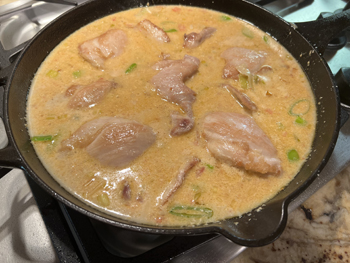 I didn’t have skin-on chicken thighs, so I used boneless, skinless ones. They were lightly browned in a skillet – the big, huge 12-inch Lodge cast iron one. They were removed, then you add a chopped up leek to the fat in the pan. As it began to soften I mushed them a bit so they’d separate into rings. Then garlic is added, then the grits, the red weapons, the red weapons liquid, milk and water. The recipe suggested adding more salt, but I didn’t think it was needed. The picture here at right is of the thighs nestled into the grits (which is very liquid at this point).
I didn’t have skin-on chicken thighs, so I used boneless, skinless ones. They were lightly browned in a skillet – the big, huge 12-inch Lodge cast iron one. They were removed, then you add a chopped up leek to the fat in the pan. As it began to soften I mushed them a bit so they’d separate into rings. Then garlic is added, then the grits, the red weapons, the red weapons liquid, milk and water. The recipe suggested adding more salt, but I didn’t think it was needed. The picture here at right is of the thighs nestled into the grits (which is very liquid at this point).
If you’re using skin-on thighs, they’re nestled into the mixture and the pan goes into a 375°F oven. With skinless thighs, I baked the grits for 20 minutes, then nestled the thighs into the grits mixture to finish cooking them. The total bake time is 40 minutes and you let the pan cool for 5 minutes before serving.
Vivian suggested serving the grits with another one of her flavor bombs, a mixture called herbdacious. I haven’t posted that recipe yet. I had guests the night I made this chicken, and we did use some of the herbdacious on the top and I agree, it made it even better.
What’s GOOD: I’ll say it again – OMGoodness. So good. There is very little fat in this (except for the chicken skin if you use it plus a tablespoon of EVOO used to brown the chicken). There’s no butter, no cream. The red weapons provide a wonderful flavor to everything – chicken and the grits. I will be making this again and again – providing I have some red weapons in my refrigerator.
What’s NOT: well, only that you need to plan ahead at least a day to make the Red Weapons first, then the chicken and grits later.
RED WEAPONS: printer-friendly PDF and MasterCook file (click link to open)
CHICKEN: printer-friendly PDF and MasterCook file (click link to open)
* Exported from MasterCook *
Chicken and Grits with Red Weapons
Recipe By: Vivian Howard, This Will Make It Taste Good
Servings: 4
4 chicken thighs — bone in, if possible
2 teaspoons kosher salt — divided
2 tablespoons extra-virgin olive oil
1 whole leek — white and light green parts, sliced into 1/2-inch rounds
3 garlic cloves — thinly sliced
1 cup grits — stone ground (Albers brand, if possible)
1 cup Red Weapons — roughly chopped
1/2 cup Red Weapon pickling liquid — here)
2 cups milk
1 1/2 cups water
NOTE: if you make this with boneless, skinless chicken thighs, go ahead and bake the grits for about 20 minutes (half the time), then add the boneless, skinless thighs to the mixture, nestling them down into the grits. It will still take 40 minutes altogether, but the chicken won’t overcook.
1. Preheat oven to 375°F.
2. Season chicken thighs with 2 tsp of salt.
3. In a 12-inch ovenproof skillet or braising pan, heat the oil over medium heat. Brown chicken skin side down, until nicely caramelized. Take the chicken out of the pan and set aside.
4. Lower the heat slightly and add the leeks, and 1/2 teaspoon salt to the pan. Sauté for 2 to 3 minutes, until the leeks have softened (and break them apart as they soften) and picked up all the browned bits from the bottom of the pan. Add the garlic and stir for about a minute, then stir in the grits, the chopped Red Weapons, the Red Weapons liquid, milk, remaining 1/2 teaspoon salt (taste to see if it’s needed), and 1 1/2 cups water. Make sure everything is mixed together in a homogeneous way and that nothing is stuck on the bottom of the pan.
5. Nestle the thighs on top of the grits mixture. They will sink a bit because the grits are watery at this point, but as long as the browned chicken skin peeks out, all is good. Slide the skillet onto the center rack of the oven and bake for 40 minutes, until an instant-read thermometer in the chicken reaches 165°F.
6. Remove skillet and allow it to cool for about 5 minutes before serving. If desired, this would be great dotted with a little Herbdacious.
Per Serving: 721 Calories; 43g Fat (54.7% calories from fat); 40g Protein; 41g Carbohydrate; 1g Dietary Fiber; 201mg Cholesterol; 1375mg Sodium; 7g Total Sugars; trace Vitamin D; 173mg Calcium; 2mg Iron; 657mg Potassium; 445mg Phosphorus.
– – – – – – –
* Exported from MasterCook *
Red Weapons – Tomatoes
Recipe By: Vivian Howard, This Will Make It taste Good
Servings: 16
2 pounds plum tomatoes — cut into quarters lengthwise
1 bunch scallions — sliced thin
5 jalapeños — sliced into thin rings
3 tablespoons minced fresh ginger
3 tablespoons minced garlic
1 1/2 tablespoons ground cumin
1 1/2 tablespoons mustard seeds — yellow or brown
1 1/2 teaspoons cayenne
1 1/2 teaspoons turmeric
3/4 cup packed light brown sugar
1 1/2 cups extra-virgin olive oil
1 tablespoon kosher salt — plus 1 teaspoon
1/2 cup unseasoned rice wine vinegar
3/4 cup white wine vinegar
NOTES: Store this mixture in glass containers as the turmeric will stain plastic. Wear an apron. Use a wide mouth glass jar, or several, to store this. You can use all of the ingredients – the oil by itself for flavoring/frying, the juice to add a piquancy to dishes, and the tomato mixture to flavor a bigger dish of something.
1. Put the tomatoes in a large, wide, heatproof bowl that is plenty large enough to hold all the ingredients. Assemble and start to “pickle” my weapons on the counter, which lets the flavors marry as they cool down. Then, once they’re mixed together and have reached room temperature, transfer to smaller containers suitable for the fridge getting an equal amount of oil, tomatoes and liquid in each one. (This recipe is sized to just barely fit into two quart-size mason jars, but you may have a little extra. While you can try to pull it all together directly in the jars, that might just be a big mess waiting to happen.)
2. In a large saucepan or Dutch oven, bring all the ingredients except for the tomatoes and the olive oil to a boil over medium heat. Let it boil for 1 minute. Then add the olive oil and bring back to a boil. Immediately pour over the tomatoes in the big bowl, pressing them down to make sure they are submerged.
3. Let the tomatoes and the liquid cool to room temperature without the aid of an ice bath or anything to speed the process along. If you’ve got room in your fridge, the big bowl can go in there. But if the weapons sit out at room temperature overnight, that’s totally fine. The more slowly they cool down, the more quickly they will pickle. Once they’ve cooled, transfer the pickled tomatoes to jars and refrigerate for a minimum of 3 days or up to 3 months. Do not freeze.
Per Serving: 243 Calories; 21g Fat (75.5% calories from fat); 1g Protein; 14g Carbohydrate; 1g Dietary Fiber; 0mg Cholesterol; 443mg Sodium; 12g Total Sugars; 0mcg Vitamin D; 28mg Calcium; 1mg Iron; 201mg Potassium; 28mg Phosphorus.
MORE NOTES: Once they’ve spent a few days in the frig, you’ll notice Twin B, the olive oil component, rises to the top and creates a lid over Twin A, the pickling liquid and the tomatoes and other solid stuff. This act of science makes the weapons and their offspring easy to separate from one another, but it’s not a pretty process. You’ll likely find yourself with your hand in the jar and a puddle on the counter. It’s easier to do if the mixture is cold. These are good on eggs, in braising liquids or soups, mashed with guacamole,, on cream cheese, mixed into cooked rice or beans, a sauce or marinade for grain, legume or pasta salads, with leftover chicken or pork, chopped with fresh herbs for salsa, blended with mayo as a dip, or stirred into potato, chicken, shrimp or tuna salad.



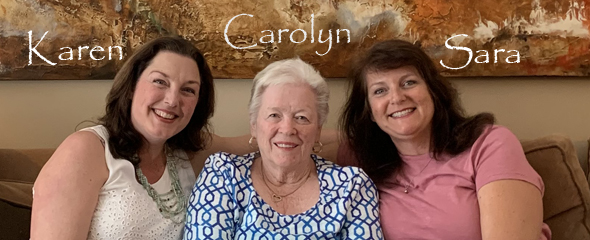
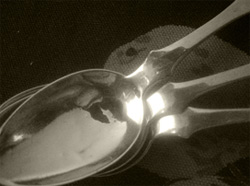

hddonna
said on September 26th, 2023:
Wow, this sounds really interesting. Both the sauce/relish and the grits dish. Will need to bookmark this one, as it will be a while before I get a chance to make it, but it sounds wonderful! I tend to leave turmeric out of recipes, as I use cloth tablecloths and I’ve never found a way to get it out of fabric. Just doesn’t seem worth it. But this sounds complex enough, I doubt if I will miss it, even if the creator of the recipe would.
Yes, you could leave out the turmeric. And yes, I agree with you about getting it out of fabric, or even wiped off my granite countertop! It’s a super recipe and I’ve used it several times since I made it a month ago. . . Carolyn T